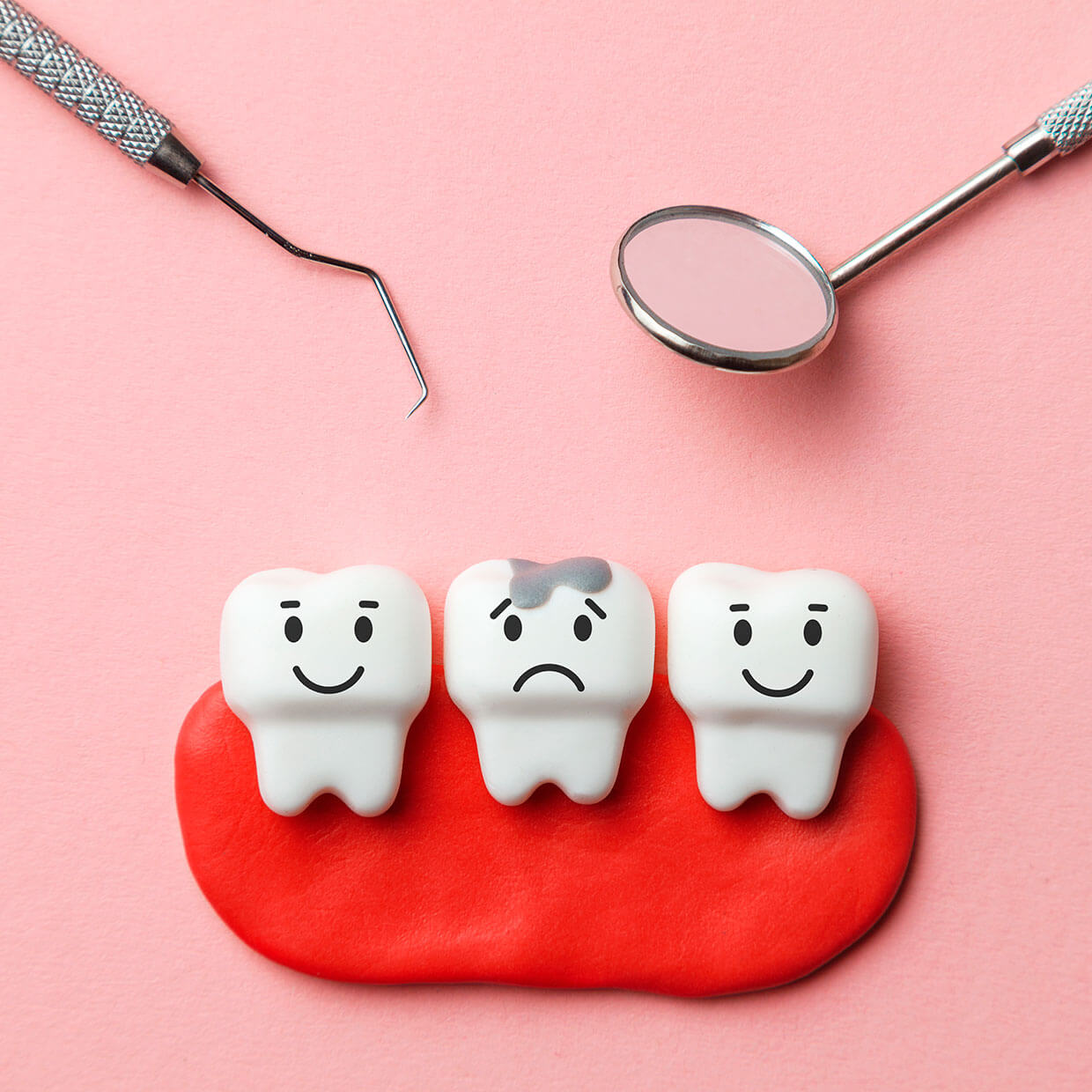What exactly is caries?
When children grab a sweet treat, or don’t want to clean their teeth at night, parents often resort to the shock tactic: If you don’t clean your teeth, you’ll get holes in them! These ugly black holes hurt. It eats away at your enamel, and if left untreated, all your teeth.
And the name of this horrible villain? Caries. But do adults really know about it? What is the reason for tooth decay? What role does diet play? What do the bacteria do to us? Is sugar as bad as people say? How can we protect our enamel? What treatments make sense? We have compiled several facts to assuage your fears – and those of your children – of tooth decay.

Types of caries
Caries, also known as tooth decay, is a disease which attacks tooth enamel. There are two different types, incipient caries and established caries.
Incipient caries is the initial stage of the disease where the tooth surface is still intact, however there are already decalcified areas within the outer layer of enamel.
If the surface of the tooth is damaged, the cause may be established caries. Depending on which tooth layers are affected, different subtypes are used to describe the level of decay:
- Caries superficialis: Damage to the enamel (top layer of the tooth)
- Caries media: Damage down to the dentin (second layer of the tooth)
- Caries profunda: Caries throughout all layers, down to the pulp (soft tissue of the tooth containing the nerves and blood vessels).
- Caries sicca: Caries has stopped its progression.
Causes and risk factors
Three factors play a significant role when it comes to the cause of tooth decay: plaque, oral hygiene and sugar consumption.
Plaque
Bacteria, saliva and food residues initially form a soft plaque, which covers our teeth like a film. This can result in our teeth feeling «furry».
This plaque should be removed at least once within a period of 24 hours using a toothbrush and dental floss. As soon as the plaque begins to calcify – a process which occurs after 72 hours – it becomes difficult to remove. Together with food residue (and the sugar contained within), bacteria decay on the surface of the tooth. This process generates acid which attacks the tooth enamel and slowly destroys the tooth if it is not cleaned or treated.
Oral hygiene
Good oral hygiene involves brushing your teeth in the morning and evening and using dental floss on a daily basis. This process removes the plaque and is an effective measure to prevent tooth decay. Using a toothbrush prevents plaque from forming on the surface and sides of the teeth, while floss allows you to reach interdental spaces where a brush cannot effectively clean. You should spend between three and four minutes cleaning your teeth.
Sugar consumption
Our diets have a large impact on the condition of our teeth. All carbohydrates can cause tooth decay; however, sugar is the worst offender – in all forms. These include household sugar (sucrose), sugar in honey (fructose and glucose) or milk sugar (lactose).
Monosaccharides have an immediate impact on our teeth, with the actual amount being irrelevant here. The major factor is how long our teeth are subjected to the sugar. It is more damaging to our teeth to sip a sugary beverage for an hour than to eat a chocolate bar in a couple of minutes, despite the latter containing far more sugar.
SteviaSweet offers numerous delicious sugar-free treats. They can help you in significantly reducing the risk of tooth decay.
Tooth decay in children
Children are extremely susceptible to tooth decay, as the enamel on deciduous teeth is more sensitive than on permanent teeth.
Too many sweets damage the teeth. These are not limited to sugary treats, such as biscuits or gummy bears, with soft drinks deserving of special attention. Oral hygiene can be a challenge, particularly for young children. However, it is certainly worth working on this subject, as the condition of teeth will only worsen if they are not cleaned properly.
The permanent teeth will initially also be sensitive. Upon first breaking through, the enamel is not fully hardened and is therefore susceptible to caries.

Symptoms of caries
Tooth decay is initially hardly discernible. Small chalk-coloured marks gradually appear on the teeth, indicating that minerals are being dissolved and that the enamel is becoming porous. If tooth decay continues, these white flecks begin to turn brown in colour.
Without treatment, the decay will slowly progress unabated, and it has the potential to affect further teeth. The ongoing decay of the tooth substance causes pain and will continue to cause further discomfort the more it progresses.
If a caries infection remains untreated, it can have dangerous consequences, potentially spreading to the jaw. From here, bacteria from the mouth may enter the bloodstream and thereby spread throughout the entire body, affecting other organs.
Frequency of caries
The number of teeth affected by caries or its consequences has reduced across all age groups over the past years. These are the results from the Fünfte Deutsche Mundgesundheitsstudie (Fifth German Oral Hygiene Study) which was presented in 2016.
Frequency of caries across different age groups at a glance:
12 years old
Approximately 80% of twelve-year-olds do not have tooth decay. The remaining 20% in this age group have on average one tooth affected by tooth decay.
35 – 44 years old
On average, eleven teeth are affected by caries in this age group.
65 – 74 years old
In this age group, the number of teeth affected by tooth decay approaches zero, with not even a single tooth affected on average.
Prevention
How can we minimise the risk of tooth decay?
Plaque
Use fluoride daily to strengthen your teeth – for example with toothpaste and salt containing fluoride. Go to regular dental checks and have your dentist perform a professional clean.
Tooth care
Clean your teeth at least twice a day for three minutes – with a toothbrush and toothpaste. This will help prevent plaque. Systematically clean all surfaces of your teeth. Clean the spaces in between your teeth using dental floss or interdental brushes.
Sugar consumption
Avoid sugary snacks. Ensure you consume balanced meals and drinks – not only will your teeth be grateful, so will your entire body.
We have countless tips for a life without sugar and a large recipe database to help you give your teeth a break from sugar.